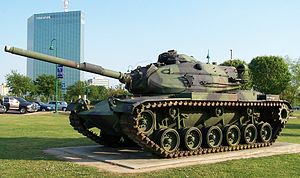
The M60 Patton is a main battle tank (MBT) introduced in December 1960. In March 1959, the tank was officially standardized as the 105Â mm Gun Full Tracked Combat Tank M60.
The M60 underwent many updates over its service life. The interior layout, based on the design of the M48, provided ample room for updates and improvements, extending the vehicle's service life for over four decades. It was widely used by the U.S. and its Cold War allies, especially those in NATO, and remains in service throughout the world today, despite having been superseded by the M1 Abrams in the U.S. military. Egypt is currently the largest operator with 1,716 upgraded M60A3s, Turkey is second with 866 upgraded units in service, and Israel is third with over 700 units of Israeli variants.
During the Hungarian Revolution of 1956, a Soviet T-54A medium tank was driven onto the grounds of the British embassy in Budapest by the Hungarians. After a brief examination of this tank's armor and 100Â mm gun, British officials decided that their 20 pounder was apparently incapable of defeating it. There were also rumors of an even larger 115Â mm gun in the works. Hence there was a need to adopt a 105Â mm gun, which emerged as the famed Royal Ordnance L7. This information made its way to the United States, where the Army had been experimenting with a series of upgrades to their M48 Patton tanks. These experiments were concerned with improving the armor and the introduction of a variety of autoloader systems, such as that used in the 105Â mm gun tank T54, and upgraded rangefinders.